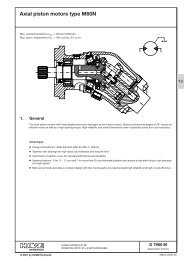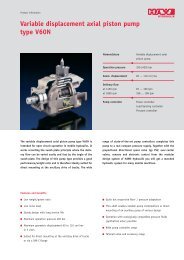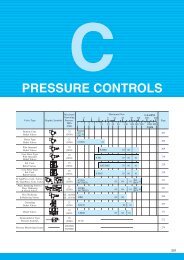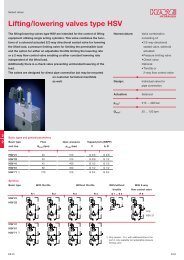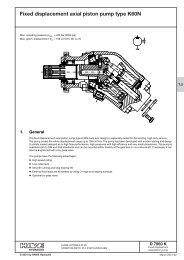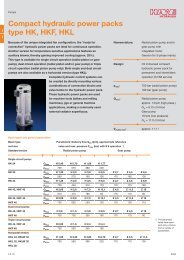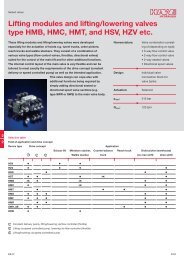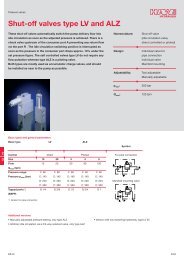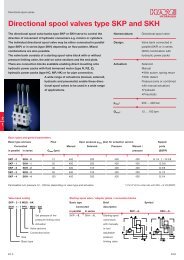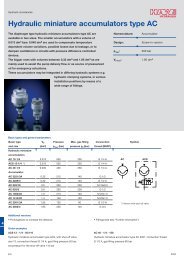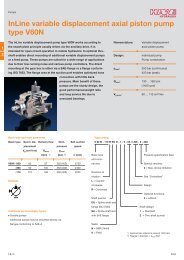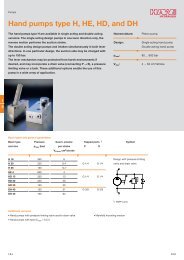DATA SHEET - Hidracomp
DATA SHEET - Hidracomp
DATA SHEET - Hidracomp
Create successful ePaper yourself
Turn your PDF publications into a flip-book with our unique Google optimized e-Paper software.
Hydraulic Fluid [Part 1]<br />
Requirements, Classification, and<br />
Properties<br />
Data Sheet<br />
■ Requirements<br />
Hydraulic pumps, control valves, and hydraulic cylinders operate at high pressure and high speed; they are also constructed of a<br />
variety of materials. Considering these facts as well as fluid temperature and ambient conditions during operation, the following<br />
requirements for hydraulic fluids must be met.<br />
● Maintaining proper viscosity as temperature ● Highly oxidation stable ● Rust-preventive<br />
changes ● Highly shear stable ● Non-compressible<br />
● Flowable at low temperature ● Non-corrosive to metal ● Providing good defoaming<br />
● Resistant to high temperature degradation ● Exhibiting good demulsibility/water performance<br />
● Providing high lubricity and wear resistance separation when mixed with water ● Fire-resistant<br />
粘 度 範 囲 於 40<br />
■ Classification<br />
JIS standards for hydraulic fluids do not currently exist, and fluids that meet the above requirements and have a viscosity<br />
equivalent to that of petroleum based turbine oils (JIS K 2213) are used. Turbine oils are classified into two types: Type 1<br />
(without additives) and Type 2 (with additives). Type 2 turbine oils contain antirust, antioxidant, and other additives. JIS K 2213<br />
Type 2 turbine oils and special oils with a viscosity grade of ISO VG 32, 46, or 68 are widely used. If there is a risk of fire in the<br />
event of fluid leakage or blowout from hydraulic systems, fire-resistant synthetic or water containing fluids are employed. These<br />
fire-resistant fluids have different properties from petroleum base oils and must be handled carefully in practical applications.<br />
Chlorinated hydrocarbon fluids are rarely used for industrial purposes in Japan, since they become highly toxic and corrosive<br />
when decomposed. While other fluids are also available, fluids used for general industrial purposes are largely categorized as<br />
follows.<br />
Petroleum Base<br />
Oil<br />
R&O Type Oil<br />
Additive Turbine Oil<br />
Special Oil<br />
Anti-Wear Type Hydraulic Oil<br />
High Viscosity Index Hydraulic Oil<br />
Low Temperature Hydraulic Oil<br />
High Temperature Hydraulic Oil<br />
Hydraulic Fluid<br />
Synthetic Fluid<br />
(Fire-Resistant)<br />
Water<br />
Containing Fluid<br />
(Fire-Resistant)<br />
Phosphate Ester Fluid<br />
Polyol Ester Fluid<br />
Chlorinated Hydrocarbon Fluid<br />
Water-Glycol Fluid<br />
Water-In-Oil (W/O) Emulsion<br />
Oil-In-Water (O/W) Emulsion<br />
■ Properties (Example)<br />
Item<br />
Specific Gravity<br />
(15/4 °C)<br />
Viscosity<br />
(mm 2 /s)<br />
Hydraulic<br />
Fluid<br />
40 °C<br />
100 °C<br />
Petroleum Base<br />
Oil (Type 2<br />
Turbine Oil<br />
Equivalent to<br />
ISO VG 32)<br />
Phosphate<br />
Ester Fluid<br />
Polyol Ester<br />
Fluid<br />
Water-Glycol<br />
Fluid<br />
W/O<br />
Emulsion<br />
O/W<br />
Emulsion<br />
0.87 1.13 0.93 1.04 - 1.07 0.93 1.00<br />
32.0<br />
5.4<br />
41.8<br />
5.2<br />
Viscosity Index (VI) 100 20 160 146 140 -<br />
Max. Operating<br />
Temp. (ºC)<br />
70 100 100 50 50 50<br />
Min. Operating<br />
Temp. (ºC)<br />
-10 -20 -5 -30 0 0<br />
Strainer Resistance 1.0 1.03 1.0 1.2 0.7 - 0.8<br />
(Same As<br />
Water)<br />
40.3<br />
8.1<br />
38.0<br />
7.7<br />
95.1<br />
-<br />
0.7<br />
-<br />
854<br />
Data Sheet



